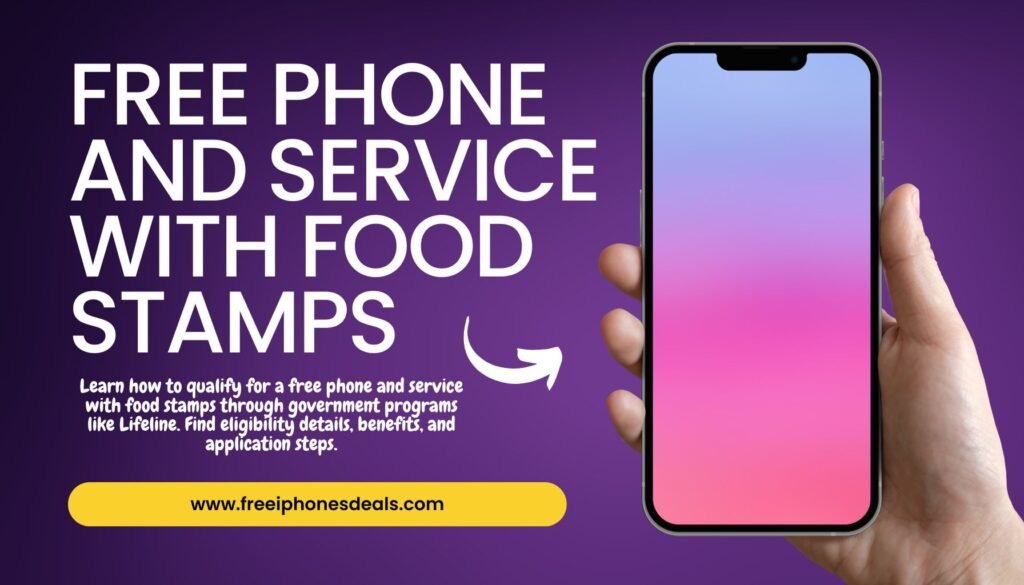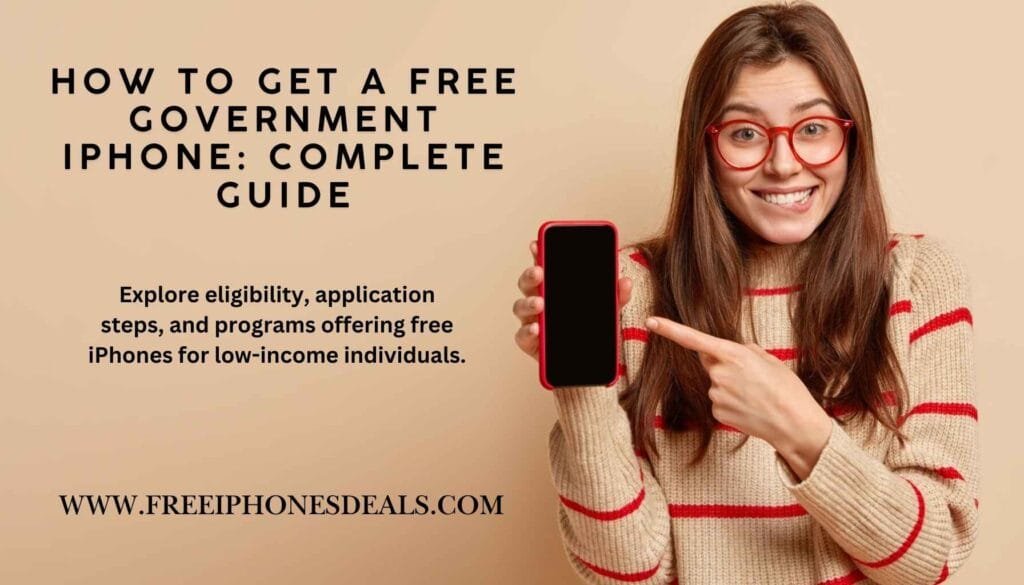
For low-income families and individuals, a free phone and food stamps service is a great advantage since it helps them remain connected free from the weight of expensive bills. Under government initiatives including the Affordable Connectivity Program (ACP) and the Lifeline Assistance Program, qualified participants in SNAP ( Supplemental Nutrition Assistance Program), sometimes referred to as food stamps, can get free phones and discounted services. These initiatives offer necessary communication tools to people most in need, therefore bridging the digital divide. Offering free call, text, and data services guarantees that people may access vital services including employment possibilities, education, and healthcare. In the increasingly digital world of today, where daily communication and access to critical information depend on a consistent phone, this project is extremely vital.
ALSO READ: FREE PHONE AND TABLETS WITH Unlimited Data
Government Programs Offering Free Phones and Service
Offering free or subsidized phones and service, government initiatives including the Affordable Connectivity Program (ACP) and the Lifeline Assistance Program enable low-income people and families to remain linked. For people who would not be able to pay the expenses of a smartphone and dependable service—which are increasingly required for daily chores including access to healthcare, employment, education, and basic communication—these programs are indispensable.
Lifeline Assistance Program
Long-standing federal program Lifeline Assistance Program offers qualified homes free or reduced phones together with monthly service agreements. Established to provide low-income people’s access to fundamental communication services—including speak, text, and internet—this initiative aims to Usually based on involvement in government help programs as SNAP (food stamps), Medicaid, or Supplemental Security Income (SSI), eligibility is Depending on the provider and certain programs, Lifeline advantages can consist in reductions on phone service or a totally free mobile device.
Affordable Connectivity Program (ACP)
A more recent project aiming at increasing internet connectivity to low-income homes is the Affordable Connectivity Program. It offers discounts on broadband internet services, therefore enabling families to remain in touch in a time when digital connection is absolutely vital. The ACP also grants savings on linked devices, like cellphones. Through the ACP, some partner carriers provide eligible beneficiaries free smartphones—often with unlimited data plans. Those who depend on consistent internet connectivity for employment, education, or government service access but cannot afford to pay the entire cost of a device and data plan may especially benefit from this.
Combined Benefits
Offering participants free phones with unlimited speak, text, and data, several wireless companies mix the advantages of the Lifeline and ACP programs. For qualified people, this dual-program approach simplifies the acquisition of the necessary communication equipment free from monthly financial concerns. Combining these initiatives helps service providers make smartphones and internet connectivity more easily available to people most in need, therefore enabling them to remain in touch with family, healthcare professionals, businesses, and colleges. Check eligibility and available options with every carrier since state and provider will affect these combined advantages.
Eligibility Requirements
You must satisfy particular eligibility requirements to be qualified for free phones and service using food stamps. Usually, these criteria rely on household income or involvement in government assistance initiatives. The main eligibility criteria are:
SNAP (Food Stamps) Participation
Should you or a member of your household be eligible for Supplemental Nutrition Assistance Program (SNAP), you are immediately qualified for both the Affordable Connectivity Program (ACP) and the Lifeline Under these programs, SNAP participants have access to free or subsidized phones and service, which helps people struggling financially stay connected more easily.
Other Assistance Programs
Additionally qualifies you for free phones and services is participation in other government aid programs. These projects comprise:
- Medicaid: low-income families’ and individuals’ health coverage.
- Federal Public Housing Assistance (FPHA): Help for low-income homes.
- Supplemental Security Income (SSI): Financial help for people with disabilities.
- Veterans Pension and Survivors Benefits: advantages for veterans and those close to them.
Should you be registered in any of these programs, you also have access to Lifeline and ACP services including free or heavily subsidized internet connection and cellphones.
Income-Based Eligibility
Income-based eligibility allows you to be qualified for government aid even if you do not take part in programs.
- Lifeline: To be eligible for Lifeline, your household income must be at or less 135% of the Federal Poverty Guidelines.
- ACP: Your household income must be at or less 200% of the Federal Poverty Guidelines to be qualified for ACP.
Although low-income households and people cannot afford the whole cost of a smartphone or data plan, these initiatives are meant to guarantee that they have access to necessary communication services.
Meeting any one of these requirements will enable you to access the tools required to apply for government programs like Lifeline and ACP, therefore enabling a free phone and service.
Participating Carriers Offering Free Phones and Service
Several carriers join the Lifeline and Affordable Connectivity Program (ACP) to provide qualified people free smartphones and service. These carriers make sure users may remain linked to necessary services by providing a range of plans including unlimited talk, text, and data. The main carriers providing free phones and service are listed below:
Assurance Wireless
Under both the Lifeline and ACP programs, T-Mobile’s Assurance Wireless division provides free Android cellphones to qualified candidates. Customers get unlimited talk, text, and data options to let individuals in need keep connected for both personal and business needs.
SafeLink Wireless
Under both Lifeline and ACP programs, SafeLink Wireless—a distributor of free government phones—offers handsets and plans to qualifying people. They let recipients handle their communication demands at no expense by offering free talk, text, and data services.
Q Link Wireless
Another company giving free cellphones and plans under both Lifeline and ACP is Q Link Wireless. Along with limitless data, voice, and text messaging, qualified subscribers get cellphones. Reliable customer service and a simple enrollment process are well-known strengths of Q Link Wireless.
TruConnect
Using Lifeline and ACP benefits, TruConnect provides free phones and service. Often including hotspot capabilities, which let receivers access the internet on their devices, their plans Users who require both a smartphone and the freedom to use the device for mobile internet connection on-demand will find TruConnect to be an excellent choice.
How to Apply for Free Phones and Service with Food Stamps

Applying is easy if you qualify for free phones and services by means of your participation in the Supplemental Nutrition Assistance Program (SNAP). Applications for free phones and services under the Lifeline and Affordable Connectivity Program (ACP) follow below:
Step 1: Check Eligibility
Establishing your eligibility for free phones and services comes first. See the carrier’s or Lifeline National Verifier websites to find out whether you satisfy the required requirements. You are immediately qualified for both Lifeline and ACP benefits if you presently use SNAP, or food stamps. Other government programs including Medicaid, Supplemental Security Income (SSI), or Federal Public Housing Assistance (FPHA) can potentially qualify you. Your household’s income should also be under the recommended ranges—usually at or less 135% of the Federal Poverty Guidelines for Lifeline and 200% for ACP.
Step 2: Select a Provider
After confirming your eligibility, look for the carriers in your area providing free phones and service options under Lifeline and ACP. Among several big carriers including Assurance Wireless, SafeLink Wireless, Q Link Wireless, and TruConnect, free cellphones and plans with unlimited call, text, and data abound. Examine their products and select the carrier most fit for your requirements. The carrier’s website provides certain plans together with any further criteria or features.
Step 3: Submit an Application
Apply by visiting a local retailer or the chosen carrier’s website. Completing the required forms will help you either online or in person apply. You will have to furnish records proving your eligibility. Usually, you will have to provide evidence of either other eligible assistance program participation or SNAP registration. Should you apply online, you could be prompted to upload these records. Make sure you have your SNAP card or another easily available form of verification to prevent application process delays.
Step 4: Receive Your Free Phone and Service
Your carrier will mail you your free phone and service plan once your application is approved. Depending on the carrier and your region, occasionally you could be able to pick up your smartphone in-store. Once you have your device, you can activate it either following the given directions or using the carrier’s customer service. Depending on the carrier and the plan you went with, your new phone should provide unlimited speak, text, and data capabilities.
Following these easy guidelines will help you to quickly apply for and get your free phone and service using your SNAP benefits, therefore ensuring your connection with vital communication services.
Benefits of Free Phones and Service
For qualified participants, free phones and service programs are priceless tools with many benefits outside only connectivity. For families and individuals with modest means, these advantages especially help them stay connected and access necessary opportunities.
Stay Connected
Reliable phone with call, text, and internet access lets consumers keep in touch to family and friends. Maintaining connections requires communication, particularly for people who might live far from loved ones. Beyond personal use, keeping in touch helps individuals interact as needed with emergency services, community resources, and support systems.
Access to Essential Services
Using free phones improves access to important services. Many telehealth companies let users plan visits, see doctors, and get prescriptions—all from their phones. Phones also provide access to educational possibilities by allowing users to engage in online courses, visit virtual classrooms, and perform research. Job hunters gain as well; they use their phones to apply, hunt for jobs, and schedule virtual interviews.
No Cost
The savings free phone programs offer are their main benefit. Devices and fully sponsored plans free members from monthly debt or upfront costs. This financial help can free up funds for other vital requirements as utilities, groceries, or child care.
Hotspot Features
Many carriers incorporate hotspot features into their offerings, which let users link other devices—such as laptops or tablets—to the internet. Students finishing schoolwork, professionals working remotely, or families needing internet connection for several devices may especially find this function helpful. It closes the digital divide and increases more general involvement in the digital economy.
Lifeline for Emergencies
In an emergency, a dependable phone could be literally a lifeline. Real-time weather notifications, neighborhood safety updates, or 911 service access guarantees consumers can remain informed and react quickly to disasters.
Empowerment and Independence
Free phones and services equip consumers the means to independently control their life. These programs improve quality of life whether it’s using mobile banking to handle money, navigating public transportation, or keeping current with news apps.
Conclusion
For those on food stamps, free phone and service programs offer a lifeline for maintaining connection and receiving vital information. Often housed under the Lifeline Assistance or Affordable Connectivity Program, these projects empower low-income people by providing dependable free communication equipment. Participants can contact family, seek education, hunt employment, and get telehealth services by means of voice, text, and internet access.
Features like hotspot capabilities improve their value even more since they let consumers stay technologically active and link other devices. These initiatives encourage more freedom and raise quality of living by removing financial obstacles to communication. If you qualify, grabbing these chances can be a game-changer since it offers resources to keep informed, busy, and engaged.


How do I get a free phone with service unlimited
https://www.geniusstech.com/best-free-iphone-government-phone/